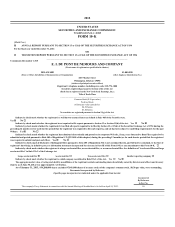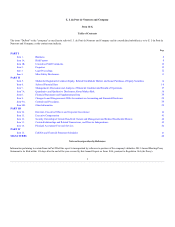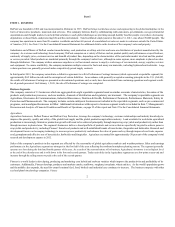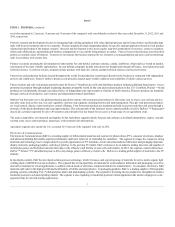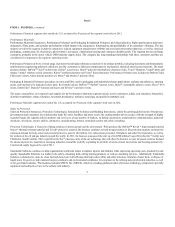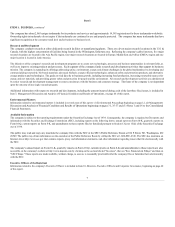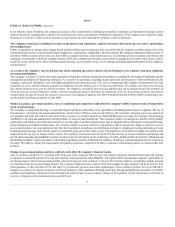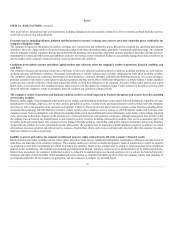DuPont 2012 Annual Report Download - page 9
Download and view the complete annual report
Please find page 9 of the 2012 DuPont annual report below. You can navigate through the pages in the report by either clicking on the pages listed below, or by using the keyword search tool below to find specific information within the annual report.
The company's operations could be affected by various risks, many of which are beyond its control. Based on current information, the company believes that
the following identifies the most significant risk factors that could affect its businesses. Past financial performance may not be a reliable indicator of future
performance and historical trends should not be used to anticipate results or trends in future periods.
The company's manufacturing processes consume significant amounts of energy and raw materials, the costs of which are subject to worldwide supply and
demand as well as other factors beyond the control of the company. Significant variations in the cost of energy, which primarily reflect market prices for oil,
natural gas and raw materials, affect the company's operating results from period to period. Price increases for energy and raw materials were not significant to
earnings in 2012 as compared to 2011. In 2011, price increases for energy and raw materials were about $2.0 billion as compared to 2010. Legislation to
address climate change by reducing greenhouse gas emissions and establishing a price on carbon could create increases in energy costs and price volatility.
When possible, the company purchases raw materials through negotiated long-term contracts to minimize the impact of price fluctuations. Additionally, the
company enters into over-the-counter and exchange traded derivative commodity instruments to hedge its exposure to price fluctuations on certain raw material
purchases. The company takes actions to offset the effects of higher energy and raw material costs through selling price increases, productivity improvements
and cost reduction programs. Success in offsetting higher raw material costs with price increases is largely influenced by competitive and economic conditions
and could vary significantly depending on the market served. If the company is not able to fully offset the effects of higher energy and raw material costs, it
could have a significant impact on the company's financial results.
Operating results are largely dependent on the company's assessment and management of its portfolio of current, new and developing products and services
and its ability to bring those products and services to market. The company plans to grow earnings by focusing on solutions to meet increasing demand for
food productivity, decrease dependency on fossil fuels, and protect people, assets and the environment. The company develops new products through multiple
methods including, but not limited to, internal research, collaborations, acquisitions, joint ventures and licensing technology or know-how. Developing and
marketing new products could be adversely affected by difficulties or delays in product development such as the inability to identify viable new products,
successfully complete research and development, obtain and maintain relevant regulatory approvals, obtain and maintain intellectual property protection,
obtain technology or gain market acceptance of new products and services. Because of the lengthy development process, technological challenges and intense
competition, there can be no assurance that any of the products the company is currently developing, or in which it will invest to develop, will achieve
substantial commercial success. Not currently matching investment choices in new products with market need and competitive offerings could adversely
affect business performance. Sales of the company's new products could replace sales of some of its current products, offsetting the benefit of even a
successful product introduction.
The company competes with major global companies that have strong intellectual property estates supporting the use of biotechnology to enhance products,
particularly agricultural and bio-based products. Speed in discovering, developing and protecting new technologies and bringing related products to market is
a significant competitive advantage. Failure to predict and respond effectively to this competition could cause the company's existing or candidate products to
become less competitive, adversely affecting sales. Competitors are increasingly challenging intellectual property positions and the outcomes can be highly
uncertain. If challenges are resolved adversely, it could negatively impact the company's ability to commercialize new products and generate sales from existing
products.
The company faces risks arising from various unasserted and asserted litigation matters, including, but not limited to, product liability, patent infringement,
antitrust claims, and claims for third party property damage or personal injury stemming from alleged environmental torts. The company has noted a
nationwide trend in purported class actions against chemical manufacturers generally seeking relief such as medical monitoring, property damages, off-site
remediation and punitive damages arising from alleged environmental torts without claiming present personal injuries. The company also has noted a trend in
public and private nuisance suits being filed on behalf of states, counties, cities and utilities alleging harm to the general public. Various factors or
developments can lead to changes in current estimates of liabilities such as a final adverse judgment, significant settlement or changes in applicable law. A
future adverse ruling or unfavorable development could result in future charges that could have a material adverse effect on the company. An adverse outcome
in any one or more of these matters could be material to the company's financial results.
8

